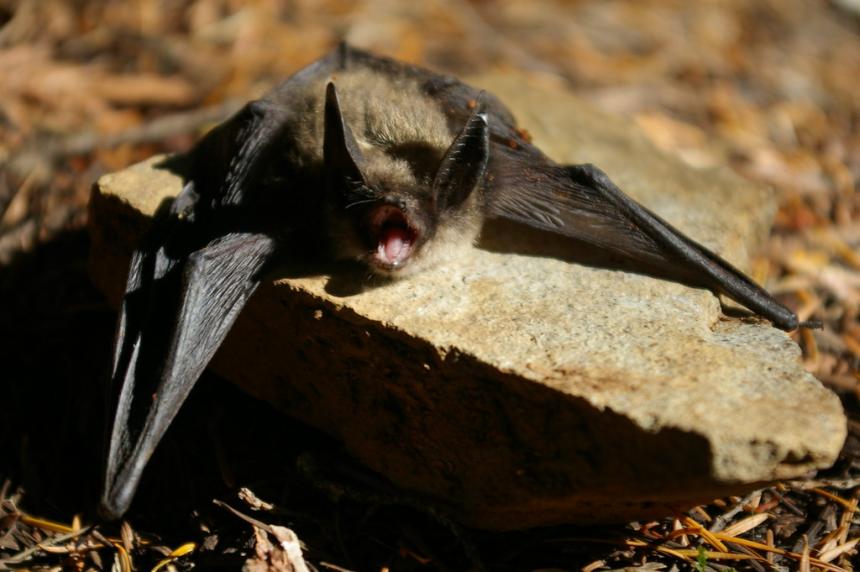Moderate
In Washington, Keen’s myotis is one of three small, long-eared myotis bats. This species is poorly known and probably rare. Loss of large decadent trees and snags is likely an important threat.
White-nose syndrome is a deadly fungal disease that has been confirmed in some Washington bat species, but to date, no diagnostic evidence of the disease has been detected in Keen's myotis, but has been detected in western long-eared bats (Myotis evotis). It is unclear which species of bats may be vulnerable to this disease in Washington. This disease does not affect humans, livestock, or other wildlife.
If you find sick or dead bats or notice bats acting strangely, such as flying outside in the day or in freezing weather, please report your sighting online or call WDFW at 360-902-2515. Do not handle bats that appear sick or injured.
Description and Range
Physical description
Keen’s myotis is one of three small, long-eared myotis bats in Washington. It is so morphologically similar to the western long-eared bat that species determination between the two is based on small skeletal differences and the two may actually be one species.
Ecology and life history
Keen’s myotis is closely associated with low elevation, moist, mature coastal conifer forests during the active season and may move to hibernacula in mid-elevation caves for winter.
Summer roosts are in tree cavities, snags, rock crevices, small caves, and buildings.
The few documented maternity sites have been found in caves and trees. Keen’s myotis females return to maternity colonies in May and give birth to a single pup between early June and mid- to late July.
Males roost solitarily. Males often roost in large trees or snags. Roost sites may be limiting in some parts of the range.
Hibernation begins in late summer or fall.
Foraging occurs more frequently in mature and old growth forests than clearcuts or young forests; riparian areas are likely important foraging habitats. Keen’s myotis flies rather slowly while foraging and is adapted to eat a variety of insects including spiders, caddis flies, moths, and flies. It is able to glean prey as well as gather prey on the wing.
Its physical characteristics of long ears, short, broad wings, and high frequency, low intensity echolocation are adaptations that enhance the ability to fly and forage in structurally complex forests.
Geographic range
This species has one of the smallest ranges of any North American bat, occurring in coastal areas from southeast Alaska to northwestern Washington, including the Olympic Peninsula and Puget Sound. Abundance in Washington is unknown, but it is assumed to be rare. Trend is unknown.
For a map of range-wide distribution and conservation status of this species, check out NatureServe Explorer.
Climate vulnerability
Sensitivity to climate change
Moderate
Keen's myotis is a relatively poorly known species, especially in Washington, thus its vulnerability to climate change is difficult to judge. It has a small geographic distribution in the state and is probably mostly restricted to moist coastal forests. The few known hibernacula (all from elsewhere in the range) occur in mid-elevation caves, suggesting that low-elevation caves may to be too warm for hibernation. Moths and spiders comprise a sizeable part of the diet, but a variety of other insects are also eaten. Warmer temperatures and changes in precipitation patterns may negatively affect roosting conditions and prey availability for the species, but this remains speculative.
Exposure to climate change
Moderate
- Increased temperatures
- Changes in precipitation
Conservation
Conservation Threats and Actions Needed
- Resources information collections needs
- Threat: Species requirements may be misunderstood because of speciation question.
- Action Needed: Conduct a full genetic analysis to understand the relationship with western long-eared bats and to determine species identification traits.
- Threat: Better understanding of habitat requirements is needed.
- Action Needed: Conduct research to understand habitat relationships, including year-round roosting requirements.
- Threat: Lack of adequate information on threats.
- Action Needed: As better population distribution is obtained, assess threats that may exist.
See the Climate vulnerability section for information about the threats that climate change poses to this species.
Preventing conflict
For some people bats don't present a problem. For others, bats can be a worry, especially when they become unwanted guests in an attic, inside a wall of a home, or inside the home itself.
Unlike rodents, bats only have small teeth for eating insects, so they do not gnaw holes in walls, shred material for nests, chew electrical wiring, or cause structural damage to buildings. Damage caused by bats is usually minimal, but they can be noisy and alarming, and the smell of bats and their droppings can be offensive. It is possible to learn to coexist with bats, and to benefit from their presence. Learn more on our Living with Wildlife: Bats webpage.
Resources
References
Chatwin, T. 2004. Keen's long-eared myotis. British Columbia Ministry of Water, Land & Air Protection, Surrey, B.C.
COSEWIC. 2003. COSEWIC assessment and update status report on Keen’s long-eared bat Myotis keenii in Canada. Committee on the Status of Endangered Wildlife in Canada, Ottawa, Ontario.
Hayes, G. and G. J. Wiles. 2013. Washington bat conservation plan. Washington Department of Fish and Wildlife, Olympia, Washington.
